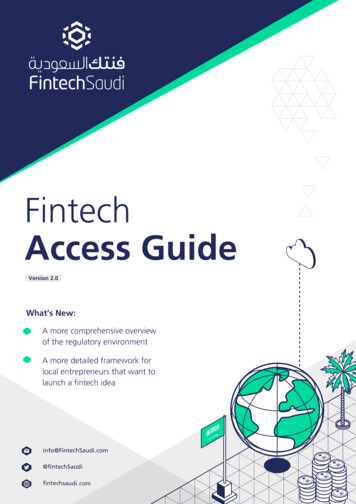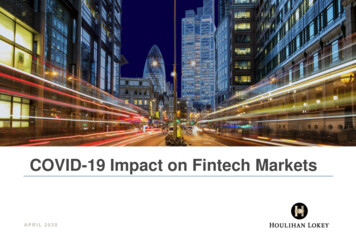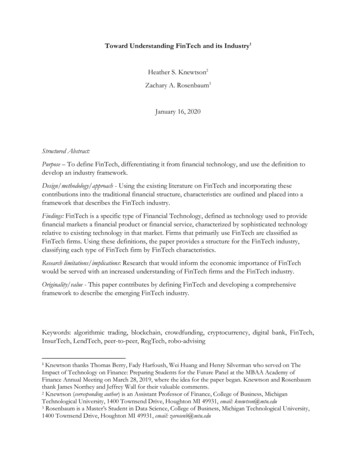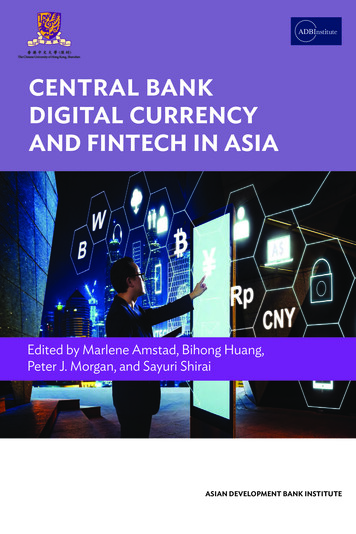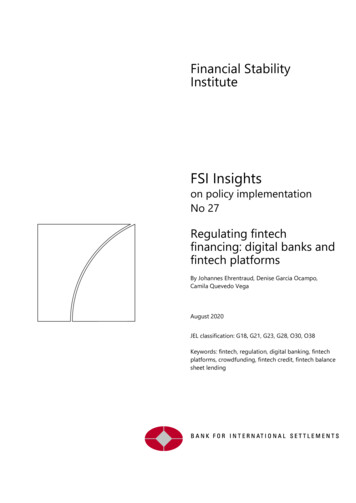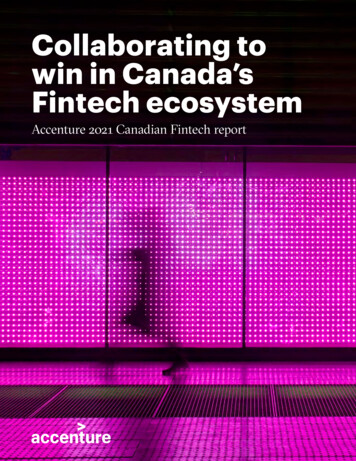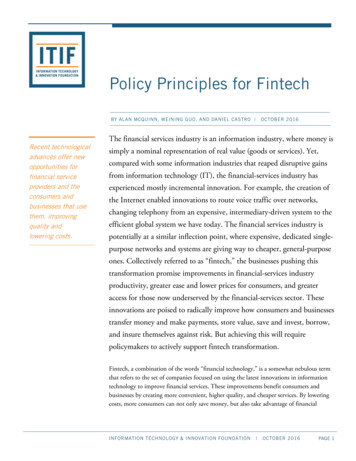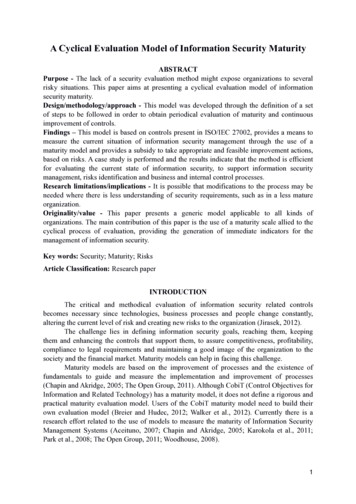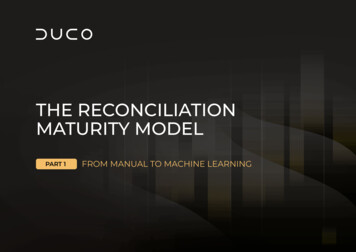
Transcription
THE RECONCILIATIONMATURITY MODELPART 1FROM MANUAL TO MACHINE LEARNING
2The Reconciliation Maturity Model: Part 1CONTENTS3Introduction: building the case for automation4Why is reconciliation so hard?6Machine learning - does it live up to the hype?8The five stages of maturity9Stage 1: Manual10Stage 2: Hybrid11Stage 3: Automated12Stage 4: Improving13Stage 5: Self-Optimising14Conclusion: moving to a Stage 5 future in the“Decade of Data”
The Reconciliation Maturity Model: Part 1INTRODUCTION: BUILDING THE CASE FOR AUTOMATIONReconciliation is an essential control functionin financial services, aimed at eliminatingoperational risk that can lead to fraud, fines orin the worst case, the failure of a whole firm.And yet, since an early push in the early 2000sthat automated parts of the very back-end ofthe system (cash and custody), innovation inthis area has stalled and operations reliant onpeople power and spreadsheets are prevalent.Christian NentwichCEO DucoIt is now 2020 and technology has movedon. So how can firms automate andstreamline their reconciliation function now?What options are there for updating andconsolidating systems?In this paper we introduce The ReconciliationMaturity Model - a best practice guide forall reconciliation practitioners, or executivesoverseeing a reconciliation function. You canuse the model to benchmark where your firmis in terms of reconciliation best practice, andwhat steps are needed to improve automation,efficiency and data quality.We will look at why reconciliation is so hardto automate, what forward thinking firms aredoing about it, and which types of technologyare needed to take your processes to the nextlevel.We will also outline what it takes to achieve the“holy grail” in the future. A place where errorsare spotted and corrected automatically, andthe need for intersystem reconciliation is allbut eliminated.We hope you find it insightful and useful.3
4The Reconciliation Maturity Model: Part 1WHY IS RECONCILIATION SO HARD?The digital transformation of financial institutions has been extensivein recent years. Firms have systematically looked to eliminaterepeatable tasks across all departments and geographies. But manyare finding reconciliation a tough nut to crack.In the vast majority of organisations, multiple point solutionsare used for specific reconciliation tasks across the business.The result is a patchwork of disparate processes stitchedtogether via spreadsheets, manual work or home-madeapplications. It’s highly inefficient, there’s no consolidation andevery process is prone to errors and fragmentation.With enough training data, machinelearning can spot errors, outliers andpoor data quality at source, reducingthe number of reconciliationsrequired. Eventually, the processshould be so seamless that intersystemreconciliations become unnecessary.But why is this still the case? A lack of standardisationIn many cases in financial services there are no strict datastandards. For example, different counterparties providetrade and position data in different formats. Each onerequires a bespoke reconciliation process or expensive datanormalisation. Increasing complexityCash or stock assets can be matched on a few basic fields,but for more complex products you need to take far moreinformation into account. Most current systems are unable todeal with every asset type that crops up in a timely manner.And that’s before we get to the range of data needed forregulatory reporting, and the associated reconciliationsrequired. Poor data qualityThe enemy of automation. Missing fields, inconsistent codingschemes and unavailability of common keys make automationdifficult when using current solutions due to hardcodedassumptions within those systems.
The Reconciliation Maturity Model: Part 1 Data inconsistency and lineage issuesAs data passes through the organisation, moving from systemto system, errors and inconsistencies can occur. Due to aproliferation of data types and formats, reconciliations arenow being introduced into ever-increasing points in the dataflow as consistency checks. As the firm grows in terms of sizeand complexity, the reconciliation function similarly balloons,introducing a smorgasbord of different systems, processesand reconciliation techniques across the business. The lack ofa transparent, consolidated view over the firm’s reconciliationsbecomes a major problem.Under these conditions, reconciliation is a thankless task.Processes take too long, are often error prone, and when datavolumes rise, so do costs and headcount. However, with the righttools and outlook, firms can overcome these problems and look toautomate and then optimise their entire reconciliation function.Processes can be consolidated, with manual and point solutionseliminated, enabling practitioners to analyse and drive additionalvalue from their data. In addition, once all the data has beennormalised onto one system, machine learning technology can beused to optimise every step of the process.With enough training data, machine learning can spot errors,outliers and poor data quality at source, reducing the numberof reconciliations required. Eventually, the process should be soseamless that intersystem reconciliations become unnecessary.That is what all financial organisations should ultimately bestriving for. The Reconciliation Maturity Model provides a blueprintto getting there.5
6The Reconciliation Maturity Model: Part 1MACHINE LEARNING - DOES IT LIVE UP TO THE HYPE?Machine learning has recently replacedblockchain at the top of the hypecurve in terms of technology that willrevolutionise financial services. Themajority of vendors in the reconciliationspace are shouting about it, and it’s easyto see why.Machine learning, if implementedcorrectly can have a great number of usesin the context of reconciliation, includingpredicting correct configurations formatching and data normalisation,parsing unstructured data, predictingroot causes of breaks and the clusteringof related exceptions. However, it’sessential to keep the following in mind:Machine learning is only as goodas the data it’s trained onWithout access to a large and varied set of training data, thebenefits will be limited. This is especially important when youconsider machine learning deployed on an installed systemcompared to a cloud-based system. In the installed version, thesystem can only learn from local data. In the cloud version, itcan train on a much wider set. Imagine using a traffic app onyour phone. The cloud-based version can give you informationbased on a huge range of anonymised data. But the localversion can only provide information based on the journeys youhave taken yourself.Beware of imitationsMachine learning is all about training models from data usingsupervised or unsupervised learning techniques. If you areusing a product that requires a software release, configurationchange or expensive consultancy to improve results, this mayinvolve hardcoding rules rather than using machine learning.You won’t get the benefit of a continuously improving model.
The Reconciliation Maturity Model: Part 1Keeping a “human in the loop”As reconciliation is a mission critical function,explainability is very important. If a machinelearning algorithm is making a decision, howdo you demonstrate to the auditor how itarrived at the conclusion? Our strongly-heldview is that machine learning is best used as a“recommendation” function in reconciliations.The algorithm should recommend a pathof action, that a user then has to accept,thus creating an audit trail. This puts thehuman in the loop, and prevents algorithmsautonomously making decisions.The user experience is keyIn tandem with the above, firms deliveringsoftware in this space need to carefully considerhow user actions are captured and fed backto the learning algorithm - to avoid nastysurprises. The impact of an action, such asdeclining a recommendation, must be madevery clear to the user, as it will likely affectrecommendations given in the future.7
8The Reconciliation Maturity Model: Part 1THE FIVE STAGES OF MATURITYWhile consigning intersystem reconciliations to history is not possibleyet - the technology isn’t quite there - firms can start to get their housesin order and position themselves to take advantage of the technologywhen the time comes.For example, the machine learning algorithms we have discussed needlarge quantities of training data to be effective. Trying to layer intelligentMANUALHYBRIDalgorithms over manual processes, or non-standardised data residingin disparate systems across the business, ultimately won’t provide anymeaningful results.The diagram below outlines the five steps of reconciliation maturity. Thekey is to recognise where your organisation lies within the model, andwhat steps you need to go through to move forward to Stages 4 and 5.AUTOMATEDIMPROVINGSELF-OPTIMISINGSTAGE 5STAGE 4STAGE 3STAGE 2STAGE 1All recs carried out manually,using spreadsheets, or viahome-made applications.High risk of error andlack of auditability.Point system(s) in placefor specific data types.Others recs carried out onspreadsheets or manually.Teams/processes aredisparate, reconciliation asa function is fragmentedand duplicate work is likely.All reconciliationsconsolidated onto one ormore automated systems.Small teams build &onboard recs, and overseeexception investigation.Significant efficiencyimprovements.Risk is reduced.One automated intelligentsystem reconciles all data.Additional data qualitycontrols are activethroughout the data lifecycle.Simplification of processesis possible, leadingto consolidation anddecommissioning of systems.Full automation across theentire lifecycle of rec, fromonboarding to exceptionresolution. Very littleinvolvement from staff.
The Reconciliation Maturity Model: Part 1STAGE 1: MANUALAlmost all firms will start off byreconciling data “manually”. By this wemean using Excel or some other formof spreadsheet, macros, home-grownapplications or - in some instances we’vecome across - printing out sheets ofpaper and marking inconsistencies witha highlighter pen!The benefits are that manual processesare quick to set up, initially verycheap, and there are no developmentprojects to worry about. However, asthe organisation grows, and the databecomes more complex, the risk of errorskyrockets. There’s no audit trail, nogovernance and it becomes increasinglyexpensive to scale. If in the 2020s you’rethrowing an increasing number of bodiesat a data matching exercise, you knowsomething’s wrong.With complex data, the macros startto become increasingly complexand opaque, creating key persondependencies. Before you know it, theonly people who know the intricacies ofa mission critical function, are a couple ofVBA experts writing code in a backroomsomewhere. Clearly as a firm grows, usingpurely manual reconciliation becomesunsustainable.9
10The Reconciliation Maturity Model: Part 1STAGE 2: HYBRIDOnce a firm has reached a certain size,or handles sufficient volumes of data,bringing in an automated reconciliationsystem becomes a necessity. For themajority of organisations, this takes theform of a point solution, usually deployedto automate high volume, low complexityreconciliations such as cash or custody.These point solutions - by their verynature - tend to specialise in a certaintype of reconciliation. Firms trading awide range of assets, or those dealingwith complex data, may need to usemultiple point solutions to handledifferent reconciliation types.At this point many firms centralise theirreconciliation function into a low-costlocation, enabling them to throw morebodies at the job at a lower cost to thebusiness. Larger organisations using thismodel will often need to employ smallarmies of people to pick up the nonautomated work. A recent study by AiteGroup came across one Tier-1 bank thatemployed over 3,100 full time employeesdedicated to reconciliation alone1. Fullautomation is needed before trueefficiencies can be realised.Even so there will be many reconciliationsthat these point solutions are not ableto handle elegantly. In these cases, firmstend to fall back on manual processes.The result is a patchwork quilt of differentreconciliation approaches stitchedtogether by manual work. The wholeprocess is costly, difficult to keep track of,and difficult to scale.1Aite Group, Trends in Reconciliation Technology, September 2019
The Reconciliation Maturity Model: Part 1STAGE 3: AUTOMATEDAs organisations grow, they tend to progressthrough Stages 1 and 2 fairly naturally.However, getting to Stage 3 is not a naturaljump. It requires all reconciliations to beautomated, which in most cases breaksthe architectural assumptions of traditionalsystems and requires a fundamental rethinkof how reconciliation operations shouldbe structured in the organisation. Thegood news is if the jump to Stage 3 is donecorrectly, then progression to Stages 4 and 5is not only easy - it’s inevitable!The key to getting to this stage is usingthe right technology. With traditionalsolutions, onboarding a reconciliationtakes a long time. Aite Group reports thatthe average time to onboard a simplereconciliation is over 17 business days onaverage, while a complex reconciliationtakes 74 days2.With these timescales, automating allreconciliations is a near-impossible task, asnew systems, data types, regulations andrequirements crop up all the time. Usingpoint solutions exclusively will alwaysresult in fragmented processes, no matter2how efficient they are at dealing with onetype of reconciliation.To reach Stage 3, firms need to be ableto onboard reconciliations in hoursor days, not weeks or months. Theyneed to be able to rely on agile, flexibletechnology that can deal with complexitywithout multi-week data transformationprojects. Once this technology is inplace, complexity and risk can be vastlyreduced, while increasing efficiency andtransparency across processes.It’s worth noting here that at Stage 3many firms will be using a combinationof a legacy technology to deal with theircore, high volume reconciliations, whileemploying a more flexible reconciliationsolution on top to handle the morecomplex and bespoke data. This is mainlydue to the fact that the legacy solutionsare on-premise systems, often part ofthe infrastructure for many years, andare very difficult to remove. However,eventually they must be replaced and allreconciliations moved to a modern, agilesystem if the firm is to move on to Stage 4.Aite Group, Trends in Reconciliation Technology, September 201911
12The Reconciliation Maturity Model: Part 1STAGE 4: IMPROVINGHere all reconciliations are automatedon one intelligent solution. This enablesgreater efficiency and oversight of thereconciliation function as a whole. It alsoenables firms to normalise their dataacross the business and implementadditional data quality checks acrosssystems, highlighting areas of incompleteor incorrect data.With all reconciliation data in one place,the team can more easily run analytics onit, find which systems or third parties arecausing the most operational pain, andprovide valuable feedback to the widerbusiness – rather than spending mostof the time of manual tasks. The work ismore rewarding and job satisfaction ishigher.Organisations are then able to startconsolidating systems and removingduplicate reconciliations which havealready been handled upstream.Processes become leaner, more efficientand more transparent.The ease that a firm moves from Stages2 and 3 to Stage 4 depends heavily onwhether it has any entrenched legacypoint solutions. For newer or morenimble organisations, getting to thisstage will be fairly straightforward – theysimply need to migrate all reconciliationsto an agile system. But for firms that relyon an on-premise solution, the migrationwill be slower, with reconciliations movedacross over a matter of years. This processis important, however, to enable theorganisation to reach Stage 5.Just as importantly, at Stage 4 the role ofthe reconciliation department is elevated.Rather than being perceived as a costcentre, with ever-increasing overheadsas the amount of data and complexityincreases, the reconciliation function canconsist of a small skilled team able toanalyse where breaks are coming fromand try to fix them at source.
The Reconciliation Maturity Model: Part 1STAGE 5: SELF-OPTIMISINGAt the time of writing, a fully selfoptimising system is not yet available.However, with machine learningtechnology improving by the day, it isvery much in development. The belowis what is possible in the not-toodistant future, assuming you have thetechnological foundations in place (ieall reconciliations are automated on anintelligent, machine-learning enabledsystem).At Stage 5, the entire reconciliationprocess is automated from end-to-end.This covers onboarding, configuration,matching, exception identification,exception resolution and managementreporting. Reconciliation practitionersonly need to check and validate thedecisions the system recommends.As more data passes through thesystem it learns, improves, reducesreinvestigation and optimisesresources. Then, as new data enters theorganisation, the system spots errors andinconsistencies immediately, before theycause issues in downstream systems.The number of internal intersystemreconciliations are reduced, and theneliminated entirely, as the reconciliationsolution is able to flag and fix breaks atsource, while providing full lineage as thedata passes through the organisation.The reconciliation team becomes avery small group who validate therecommendations the system makes,and investigate any outlier breaks thatthe system is not able to identify and fixitself.13
14The Reconciliation Maturity Model: Part 1CONCLUSION: MOVING TO A STAGE 5 FUTURE IN THE“DECADE OF DATA”As we enter this new decade - the “decade of data” - webelieve The Reconciliation Maturity Model will help morefirms get closer to Stage 5: the “holy grail” of reconciliation.This optimal future isn’t that far away. Machine learningis already being employed within modern systems andoffers exciting benefits for users, which will only improvewith time. Also, as more people sign up to use thesesystems, this creates a flywheel effect as the machinelearning algorithms start to improve with the amount oftraining data they can access.Our recommendation to firms would therefore be: getready to take advantage of machine-learning, and a futurewhere reconciliation can be minimised.As we enter this new decade - the“decade of data” - we believe TheReconciliation Maturity Model willhelp more firms get closer to Stage 5:the “holy grail” of reconciliation.The best way to do this is by choosing a SaaS system,where the amount of training data is ever-increasing.Machine learning algorithms on installed systems areonly able to train on a limited set of data. By positioningthemselves as Stage 4 (or 5) organisations, firms will notonly see immediate benefits, they will also be ready totake advantage of new functionality when it arrives.Attitudes towards cloud-based infrastructure willcontinue to change as the adopters reap the benefits andlaggards struggle to keep up. The net beneficiary of all ofthis will be the people who work in reconciliations - whowill get more power to do their jobs properly instead ofdoing tedious manual work - and the end clients receivingimproved and more responsive service.In future papers, we will look in depth at different partsof the reconciliation process, including:1. Onboarding and Configuration2. Matching Control and Workflow3. Reporting and Analytics4. System Installation and Deployment
About DucoDuco is a global provider of self-service data integrity andreconciliation services. Our mission is to make managingdata easy. The cloud-based Duco platform empowers endusers to aggregate, normalise and reconcile data on demand- without infrastructure projects. Firms rely on us to increasebusiness agility, reduce risk, stay compliant with regulationand dramatically improve efficiency across a range of missioncritical tasks. Customers can be live in 24 hours, with results in7 days and tangible business value in 30 days. Headquarteredin London, with offices in New York, Luxembourg, Edinburgh,Wroclaw and Singapore, Duco’s customers include globalbanks, brokers, asset managers, exchanges and middle andback office outsourcers.For more information go to www.du.co
Maturity Model - a best practice guide for all reconciliation practitioners, or executives overseeing a reconciliation function. You can use the model to benchmark where your firm is in terms of reconciliation best practice, and what steps are needed to improve automation, efficiency and data quality. We will look at why reconciliation is so hard


